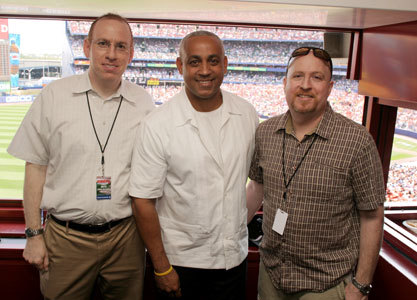Woodmere dentist meets bone marrow recipient
Issue of August 29, 2008
By Rachel BladyA Jewish Heritage Day audience of tens of thousands watched on the big screen at Shea Stadium Sunday as Gary Schnitzer, a New Jersey man recovering from leukemia, and Dr. Steven Eisenberg, a dentist from Woodmere who donated the bone marrow that saved him, met for the first time.Schnitzer was introduced first, and then Dr. Eisenberg walked through the door of a luxury box donated by Mets owner Fred Wilpon to the Gift of Life, which facilitates bone marrow transplants. Schnitzer first shook Eisenberg’s hand firmly, then pulled him into an embrace. Tears were wiped away, pictures were snapped and greetings were exchanged. There was so much these two didn’t know about each other, despite the strong connection they shared.
Hearing his diagnosis was like “getting hit in the head with a two by four,” said Schnitzer. The leukemia was discovered after his wisdom teeth were removed and his mouth didn’t recover. He has a wife, Laura, and a son, Cole, who is eight years old. Just months after his operation, Schnitzer biked one hundred miles to raise money for his cancer hospital.
Eisenberg is a modest, unassuming guy who is clearly uncomfortable in the limelight. He made it plain that he only agreed to participate in a public display like the one at Shea in the hope that it would encourage others to be tested into the bone marrow donor registry, and if discovered to be a match, to actually donate.
Eisenberg was originally tested to see if he was a match by the Gift of Life organization at a community-wide testing at the Young Israel of Woodmere. Jay Feinberg, now the executive director and a recipient himself, founded the Gift of Life.
“I was the only possible donor — there were no other close matches,” explained Eisenberg. “So how can you live with yourself knowing you could have helped someone and you didn’t?”
The meeting was planned with no prior knowledge on either side of who the other man was, aside from gender and age. It is widely discouraged for donors or recipients of a bone marrow transplant to be given much information about the other. Aside from the rarity of actually finding a match, less than half of such procedures are successful.
Recipients and donors do not always both sign the consent forms to meet each other that are routinely sent a year after the transplant. But both of these men unknowingly said the exact same thing — that curiosity factored into the decision to meet. Schnitzer had been in the hospital for five months and was constantly around doctors and nurses, but was never given any information about a possible donor. Once the opportunity to be introduced to Eisenberg presented itself, “my wife was itching to meet him,” said Schnitzer.
A motto printed on Gift of Life t-shirts given out to the two families said: “Giving hope, one family at a time.”
What was running through Schnitzer’s mind during the meeting? “All I can really think of is, thanks for saving my life. It’s hard to say much more than that.”
How a match is made
The technology of finding bone marrow matches —called tissue typing — has advanced and changed a great deal in recent years. Today, a sample is fully tested using DNA typing techniques, providing much more comprehensive and accurate test results. Volunteers provide a sample simple cheek swab; no needle is necessary. Potential donors recruited in the 1990s took a blood test — with the requisite needle — but the tissue typing was very less thorough as donors were only partially typed.
Donors recruited since that time represent 95 percent of transplants facilitated. While donors do not need to be re-tested, they can increase their odds of being selected by sending away for a cheek swab kit and re-testing themselves quickly and painlessly at home. The swab goes back to Gift of Life by mail to be tissue typed and re-added to the database.
New volunteers are encouraged to join the registry in the same fashion, and Gift of Life is especially seeking younger donors because they remain in the registry longer, facilitating many more transplants over time.
What’s next?
The foundation is also trying to raise awareness about their Jewish umbilical cord blood bank, which many believe is the future of transplantation, according to Gift of Life founder and executive director Jay Feinberg. For more information about the Gift of Life Bone Marrow Registry and to order a cheek swab kit, please go to www.giftoflife.org.

 39.0°,
Fair
39.0°,
Fair 




